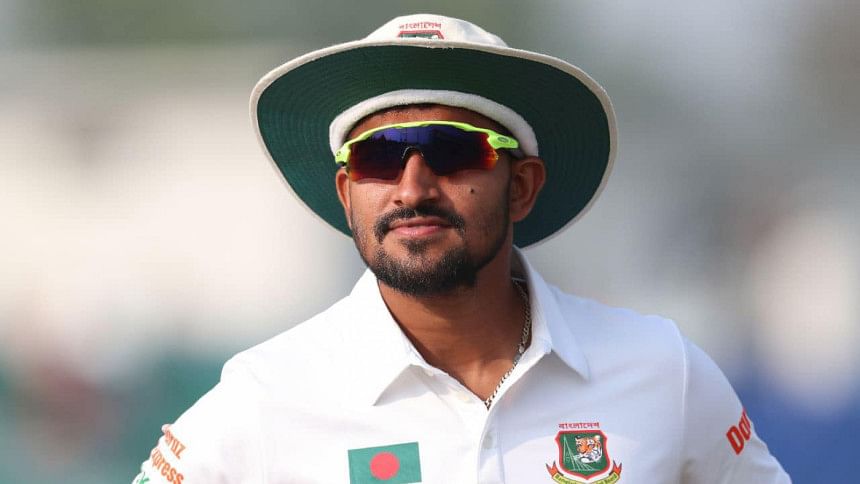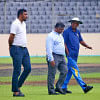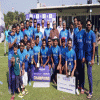‘Even during the flood, I was running'

Having made his Test debut back in November 2018, Khaled Ahmed then played in another Test at Hamilton in 2019 before he found himself jolted by injury. Waiting in the wings through the pandemic, Khaled resurfaced as a sort of red-ball specialist with good performances, especially away from home. While he struggled at home conditions, he has been able to leave a mark with away performances. Khaled talks about the two captains he has played under so far in Tests, how his bowling tends to be at home and away from home, working with Donald and attending the 'white-ball camp' in Sylhet last month with The Daily Star's Abdullah Al Mehdi.
DS: How did the opportunity come about to work with the white-ball team in Sylhet?
Khaled Ahmed (KA): I was told beforehand to be in Sylhet. Since I had [DPL] Super League coming up, I was told, 'Come with us and let's see what happens.'
DS: Hathurusingha called you?
KA: Yes, he called me himself.
DS: How was the camp?
KA: Since I play red-ball cricket mostly, he [Hathurusingha] didn't see me with the white ball and he wanted to observe. When I bowled there, he shared things on what to do in death overs and went over other aspects. In the future I may have an opportunity, so he told me that if it does, I have to be ready. He told me about how the situations are different in white-ball.
DS: Expectations in white-ball format?
KA: If I get an opportunity then I will try to play well.
DS: How is the competition among the pace unit in terms of increasing pace?
KA: (Laughs) Everyone is trying it. But the way cricket is going on, you won't be able to do it all with pace. You need various kinds of skills and everyone is also looking to raise their skills along with increasing pace. When you don't have skill, pace won't do anything.
DS: Comfortable with your pace?
KA: My pace wasn't that much before but now it has increased. I think it's ok if I am in the 140-142 region. I can't just be Harris Rauf and start bowling at 150. His pace is natural. I had to grow that facet. My natural pace was 130-135 before and now it has increased. Working hard for two-three years I can maybe reach 145 but he got it naturally.
DS: How important is fitness in that regard?
KA: Your fitness, and your body balance all come into the equation. There are bowlers who bowl fast but their body isn't supporting it. If your body doesn't support that pace, you will definitely get injured. You need strength and stamina to keep your fitness. I started focusing on fitness in 2019 after the injury. During Covid-19, people at home saw my struggle. I would go to so many places just to run. The little guys in my household became my coach and I would stay out in the fields all day. Even during flooding [at Sylhet], I was doing my running in water. After injury, I was realising that I am losing something. I have focused on it and I haven't stopped running. I can run a lot.
DS: Not getting wickets was a blow sometimes?
KA: It was a big disappointment as a Test bowler. After bowling some 300 deliveries I got the wicket of Babar Azam and that's bad. But I was relieved after getting that wicket. Then I started getting wickets. My favourite performance will be the one in West Indies. Our previous coach Otis Gibson helped a lot and then Donald continued the progress.
DS: How has your experience been with Donald?
KA: He is very different and has a good understanding of the theories. He talked about how I had a great engine. He wasn't focusing on my natural game and allowed me to go about it my way.
DS: Donald talks to you about the kind of aggression that he himself had?
KA: It is something natural and has to come from inside. No one is lesser [in terms of aggression] than the other in our team whether you talk about Taskin [Ahmed] or Ebadot [Hossain], Shoriful [Islam, Hasan [Mahmud] or me.
Donald tells us, 'Keep your natural game intact and if there is any adjustment needed, I will tell you.' He gives everyone that freedom and that's why everyone's doing well. He told me my wrist positions were okay and to keep working on my lengths and staying with my process. Just by watching, he can pinpoint what you need to work on. He is one of the legends of the game and he has played so much.
DS: Many have pointed out that your first delivery always goes down the leg side. What is that about?
KA: You have noticed it and even Shakib bhai tells me that. The thing is that I get in-swing from the natural angle and at times it might even get you a wicket. For example, I got Brathwaite's wicket.
DS: You do that intentionally?
KA: No (laughs). It's because I try to bring the ball in. I figured out why it happens. Since I try to bring it in, the natural angle takes it to the middle and leg stump. I am coming from close to the crease and it happens but I can also bowl from a little wider of the stump (shows where he is bowling from in relation to the stumps) so it can be rectified. But you see, sometimes batters are not prepared to play that delivery on the first ball.
DS: Talk us through your role in Tests?
KA: You can't think about a lot of things in Test. My target is to get dot balls and set up the batters so I can get their wickets. Often at home, we don't have pace-friendly wickets and I play the supporting role. I don't bowl over four-over spells but in Tests sometimes you need to go through six-over spells. I am bowling three-over or four-over spells in Bangladesh.
When I play abroad, the pace is different. At home I average 138 or 139 and what happens is I play the supporting role. If I get a wicket, that's great but the idea is to contain runs and support the spinners so that they can get wickets. When we travel abroad, the spinners play that supporting role. Ebadot won the match in New Zealand but Miraz was there in the supporting role and he was very effective. So according to conditions, the team is made.
I got KL Rahul out twice [in Chattogram] but when we came here at Mirpur, neither I nor Taskin [Ahmed] got wickets but we played the supporting role. Sometimes the captain brings me on for wickets like at Mirpur against India when [Ravichandran] Ashwin and [Shryas] Iyer were batting. I tried with my everything but unfortunately, it didn't happen and we lost that match. If I get wickets with the new ball that's fine but when I come later with the old ball, I need to contain and if I get wickets that's an achievement.
DS: How do you differentiate between attacking and defensive tactics?
KA: I know from the field setup already. Sometimes you save runs by being attacking. In the last Test, boundaries were coming from behind the wicket and I was told [by team management] that I should have taken precaution. That kind of setup is not a safe setup but rather an attacking one since you are bowling well but going for runs and economy-rate increases.
You need to observe batters for more than just two or three-over spells as you need to make the batsman play. Since we had three pacers and two spinners, I was used in small smells. You need to get a minimum of 18 dots to get the batter out. The pressure builds and a chance maybe created. It's a chance though and you need to take it.
DS: We often heard pacers not being vocal in terms of their own field setup. Do you decide how you want to bowl?
KA: Yes, the bowler is asked what he wants. The captain then does what's required but also the captain instructs on what's needed. The bowler is always asked about the field, but of course, the captain can interfere. The bowler is given priority but if it's not working, the captain steps in.
DS: What is it like to bowl on home surfaces?
KA: I have come to the national team by bowling on home tracks. Last BCL, there was nothing on offer in the wicket at Cox's Bazar for the bowlers but I still got five wickets just before the Ireland Test. I felt that I could do better at home surfaces. The teams that I have played for, always support me. Since I have played Tests, I know what to do. I try things in domestic cricket and I got success in the BCL with my plans.
And I get a boost from having that responsibility. The same priority is given to the national team. I am told 'Go with your plan and I will help you with everything'. Shakib [Al Hasan] bhai always says that 'Tell me where you need the fielders. Whatever you do, I will back you up. Just bowl as you want to.'
When I was injured, Mominul [Haque] bhai supported me and helped me immensely. He told me to keep trying and then I will be able to do it. I got support from him and I tried myself too. He wanted me onboard and the team did as well, so from there I played in South Africa.
Both of them [Mominul and Shakib] are good captains and both supported me heavily. Mominul bhai still does that without being captain. He wanted pacers in the side. Pacers win you matches. You look at Ebadot's performance at Mount Maunganui for instance. Would we win the match without that performance? We almost seized the game in South Africa as well.
DS: Did you get more help from surfaces abroad?
KA: There is more seam movement as they are sporting wickets. Here there are spinning wickets or a mix of slowness in the surface. Last Test, there was no real pace in the surface and if we wavered in line, it could be hit with a straight bat. I didn't get much swing or reverse swing and it's very difficult to get wickets in Test since you need to make the batter move. Even in Bogura, batters are always shaken. When they are shaken, you can get wickets.
DS: When can our pacers have more effect here? Is it a matter of climate?
KA: It could be a matter of climate and the soil. There is rain across the year. In Asia, especially in Pakistan, wickets are actually very flat. Away conditions, mostly there is cold weather. The weather however is different here. The moisture is not there at home.
DS: Isn't it difficult to not get advantages at home despite being ready for away tours?
KA: We grew up in Bangladesh. Look at what Pakistani bowlers can do [on flat surfaces]. We can't give excuses. But we also need to understand the roles within the team. When your role is clear, you can play with freedom. You also need luck because getting wickets isn't easy. The pacers in Bangladesh are all doing well. Look at Taskin, Ebadot, [Rezaur Rahman] Raja, Shoriful [Islam], Hasan [Mahmud] and me. No one can be judged by just one or two matches. There are not many red-ball opportunities and domestically whenever I have the chance, I try to play most of the time.
DS: You have worked with wobble seam. How do you experiment?
KA: I began at South Africa but first I tried it in domestic cricket. You can't do something right from the off. When I used knuckle deliveries, I practised for seven-eight months and began with Premier League. When it was going well in the Premier League, I tried it in BPL and then in Tests. I got wickets in Tests with knuckle delivery and it's a process. You can't implement something from the get-go. You have to take time and I don't try it unless I feel it's reached perfection.
DS: How does wobble seam trouble batters?
KA: When there is moisture in the surface, batters don't know whether the ball is coming in or going out. That's the thing. When the seam wobbles, it creates that confusion. When the ball lands well, it could go in or out and the batters will be confused but I will know. I have seen it on Youtube and talked to various coaches. Mohammad Shiraj always uses that wobble seam and since they use SG ball, it's a very dangerous prospect. With Duke balls, it's even more dangerous.
DS: How was the experience of using Duke balls in NCL?
KA: It's good for the batters and good for the bowlers. There are some help and you have a chance even on dead wickets. The wicket in West Indies where I got a fifer, was pretty flat. The Duke ball moves quicker and there is some swing. The seam actually settles nicely on the surface and for reverse, you need a straight seam and the ball needs to be hard.
DS: Is it a problem to get reverse swing when you use wobble deliveries more?
KA: No, it's not. The way I will release the delivery, it won't affect the shiny side. I have an understanding of it and don't do it unintentionally.
DS: Does the white-ball swing more?
KA: With the new ball it swings more and it reverses later. Red ball is a whole day of cricket. You can't focus on a lot of things; you need to be specific. In white-ball, there are a lot of situations with new ball, in the middle overs and then the death overs.
DS: Are you working with white-ball?
KA: I am working on yorkers but I won't try that in matches yet. When my confidence grows, I will be able to do that. I have been using the knuckle ball which is a good delivery in Bangladesh as you get some purchase.
DS: Is it true that you prefer white-ball cricket just as much as red-ball cricket?
KA: I like both. Red-ball cricket is my favourite since I have been playing more in that format domestically and internationally. Unfortunately, I haven't gotten much success at home but I am trying.

 For all latest news, follow The Daily Star's Google News channel.
For all latest news, follow The Daily Star's Google News channel. 








Comments